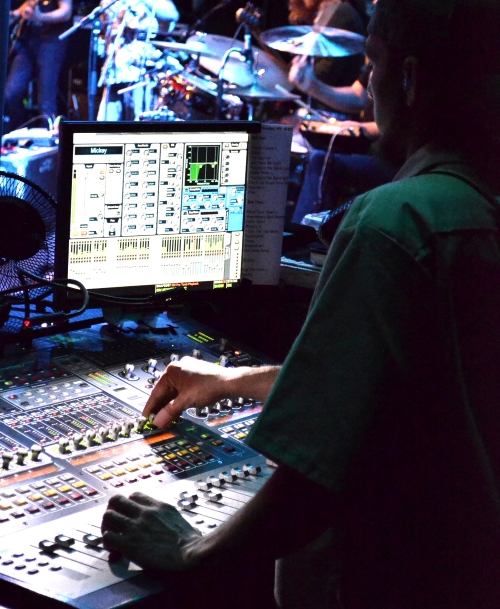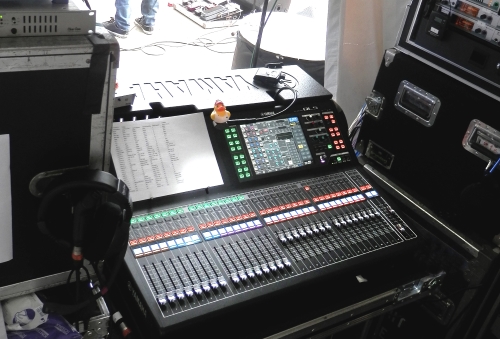
Kick Me
The one exception to my “identical wedge” policy is the drum fill. This is commonly an oversized loudspeaker, often with a subwoofer as well. Play with the sub’s polarity to damp the kick drum head’s resonance, rather than reinforce it. This buys a few extra dB of gain.
I prefer to run the sub on a separate mix, for the same reason I run my main system subs on an aux. The drummer will not appreciate wind noise from the cymbal mics rumbling through his sub, and neither do I. Cleaner-sounding mix, better control of LF energy on stage, a no-brainer.
Listen Up
OK, so about that cue wedge. FOH is located in the audience because we make mixing decisions on the audience’s behalf, so we need to hear what they hear. See where I’m going with this?
I need to hear what the artists have coming out of their wedges in order to make helpful adjustments to their mixes. I use a cue wedge tied into the desk’s solo bus, placed off to my right on the ground at FOH.
Nearfields or headphones just don’t sound the same. I delay the wedge to sync to the PA’s arrival – otherwise it’s just plain annoying. And yes, I use in-ear monitors to cue IEM mixes. If you use headphones, use closed-back cans and be aware that they are likely not representative of IEMs below 100 Hz.
MON From FOH Gain Structure
Raise a hand if you’ve had this problem: you’re mixing monitors from FOH but the old, beat-up monitor rig can’t keep up with the shiny new modern line array mains. If you employ the standard FOH gain structure (channel fader at 0 dB, add gain at preamp until it’s loud enough), you have headroom for days out front but your bus sends are all maxed out and the artists still want more.
So you have to go back and crank up the preamp on a few channels, which forces you to pull back your channel faders to a new, lower nominal level. Now your channel faders are normalized to (“living at”) different spots, so good luck putting it back after the big guitar solo. You can end up with a mix that is shifting all over, or one that gets louder and louder.
I handle these situations by normalizing my channel faders to -10 dB or -12 dB (whichever is clearly marked on the surface) rather than 0 dB. This gives the monitor rig a 10 dB head start on gain while still providing an established (and visual) norm. You can also solve this problem by pulling down the main fader, but be wary of overdriving any post-fader sends, such as aux-fed subs.
Hybrid Configuration
Smaller to mid-sized events can fall in a weird overlap where we mix monitors from FOH all day but the headliner has a dedicated monitor engineer. Sure, you could re-patch the entire monitor rig during the changeover, but is there a better way? Maybe.
If the FOH and monitor consoles can communicate digitally (MADI, Dante, AES50, etc.), I suggest the following: use the physical outputs on the monitor desk to drive the wedges all day, eliminating the need to hard-patch later. We can shoot the mixes from FOH over the digital link to the monitor desk, and configure the monitor desk to simply route the incoming mixes straight to the analog outputs. This “point-to-point” routing is supported by most digital desks and bypasses the monitor desk’s DSP entirely.
It’s super convenient because the console can then be configured ahead of time by the monitor engineer without disrupting the show in progress – similar to putting a lighting console in BLIND mode. (Hmm, DEAF mode?) When it’s go-time, simply swap the analog output source to the local mixes and you’re good to go.
Cautionary Tale
I’ll close with an example of my own stupidity (of which there are numerous instances). A keyboard player kept requesting ridiculous increases in monitor level. I was thinking “Is he deaf?”
No, he just couldn’t hear anything – the power cable had vibrated loose from his powered monitor. Those “IEC” connectors are pesky, you’ve got to tape them. Turns out they put power indicator LEDs on the front grille for a reason.
Oh, and make sure to return the mix to a reasonable level before reconnecting the power… (File under “Mistake you only make once.”)

